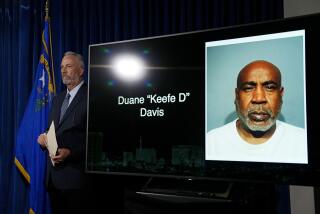Trial Begins in 1966 Murder of Black Farmhand
- Share via
JACKSON, Miss. — The courtroom was full of ghosts.
There were fuzzy, 36-year-old pictures of a murdered black man, and words from one of three alleged killers, a white racist who had died years ago. Much of that old testimony was about the purported ringleader, who is dead too.
That left only Ernest Avants -- sitting hunched in his wheelchair at the defendant’s table Wednesday as federal prosecutors opened their case against him in the 1966 murder of a farm worker in a national forest near Natchez.
The case, playing out in a digital-age courtroom but heavy with history, marks the first civil rights-era murder prosecution by federal authorities. Some key witnesses are no longer around, including the two men with whom Avants allegedly acted, Claude Fuller and James Jones. Those who have survived must rely on memories.
Avants, who is 72 and weakened by a stroke and poor health, is accused of helping murder Ben Chester White; his shooting allegedly was part of a plan to draw attention away from a civil-rights march then making its way from Memphis to Jackson, and possibly to lure the Rev. Martin Luther King Jr. to southwestern Mississippi in order to kill him as well.
“It was a brutal murder of a 66-year-old black farmhand,” prosecutor Paige Fitzgerald told a racially mixed jury of 10 women and two men.
Fitzgerald said Avants was part of a trio of Ku Klux Klan members who took White into the Homochitto National Forest and killed him on June 10, 1966. Avants allegedly fired a single shotgun blast into White’s head -- the final blow after as many as 18 rifle shots allegedly fired by Fuller.
The men, who worked at a paper mill, then dumped White’s body from a bridge into Pretty Creek, Fitzgerald said. It was discovered two days later by a family who had gone to the spot for a Sunday swim and picnic.
But Avants’ lawyer argued that his client did not kill White, and knew of no plans to do so. He said there was little evidence White died as a result of a shotgun blast -- if one was fired at all.
“It was a horrible crime. But the evidence doesn’t show beyond a reasonable doubt that this man here did it,” defense attorney Tom Royals said. He said the prosecution would present decades-old testimony by Jones, now deceased, that was both self-serving and full of lies.
As Royals spoke, Avants sat without expression, the fleece collar of his tan coat pulled up above his ears.
Other modern-day prosecutions of civil rights-era murders have played out in state courts. This case offers authorities a second chance at Avants, who was acquitted on state charges in 1967 by a racially mixed jury after a two-day trial.
During that trial, Avants’ lawyer argued that his client was not guilty because White was already dead when he was hit by the shotgun blast. Prosecutors at the time chose not to offer several key pieces of evidence, including admissions by Avants to FBI investigators who were probing a separate case.
The 1967 prosecutors also did not offer a confession by Jones that implicated Fuller and Avants, nor did they call as a witness a former highway patrolman, Donald Butler, to whom Jones identified the pair as the killers.
Fuller was never tried, because of ill health, and jurors were unable to reach a verdict in the Jones trial.
For more than 30 years, Avants’ acquittal protected him from double jeopardy -- being tried again by the state for the same charges. But then federal prosecutors learned from ABC’s “20/20” that the killing had taken place on national forest land, opening the way for the U.S. government to prosecute. He was indicted in 2000.
The trial’s first witness, Eddie Walters, was 11 years old when he and his family went for a picnic at Pretty Creek. He recalled going to the edge of the bridge with thoughts of jumping into the water below.
What he saw “scared me to death,” Walters said. It was a corpse at the edge of the water, he said. Walters recognized a photograph of White’s body as it appeared on courtroom video screens. The jury also heard from Jones in the form of testimony from two preliminary hearings and a separate confession to police weeks after the crime. In his statements, Jones said Fuller inducted him into a small and secretive racist group called the Cottonmouth Moccasin gang, then described a scheme to kill White as a way to steer attention from the well-publicized march and perhaps to “get old Martin Luther King.”
Jones said Fuller asked for White’s help to find his dog and to help pick up some spilled hay. In Jones’ Chevrolet, the three went down a gravel road to Pretty Creek and pulled over. Fuller shot White repeatedly at close range and then Avants fired once, according to Jones’ statements.
Jones said at the time that he was not sure whether White was still alive when Avants fired.
More to Read
Sign up for Essential California
The most important California stories and recommendations in your inbox every morning.
You may occasionally receive promotional content from the Los Angeles Times.













